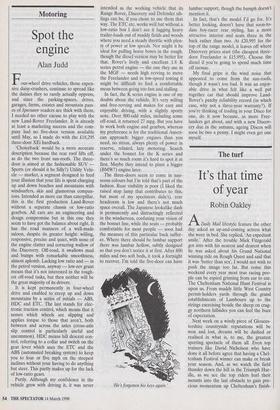Motoring
Spot the engine
Alan Judd
Four-wheel drive vehicles, those expen- sive daisy-crushers, continue to spread like the daisies they so rarely actually oppress, and since the parking-spaces, drives, garages, farms, estates and mountain pass- es of Spectator readers are thick with them, I needed no other excuse to play with the new Land-Rover Freelander. It is already at least a marketing success and the com- pany had no five-door version available until May, so I made do with the £18,295 three-door XEi hardback.
`Choiceback' would be a more accurate description because the rear roof lifts off, as do the two front sun-roofs. The three- door is aimed at the fashionable SUV Sports (or should it be Silly?) Utility Vehi- cle — market, a segment designed to feed your illusion that your life is spent charging up and down beaches and mountains with windsurfers, skis and glamorous compan- ions. Intended as more car than caterpillar, this is the first production Land-Rover without a separate chassis or low-ratio gearbox. All cars are an engineering and design compromise but in this one they seem to have got the balance about right. It has the road manners of a well-made saloon, despite its greater height: willing, responsive, precise and quiet, with none of the engine clatter and cornering wallow of the Discovery. Off-road, it swallows mud and bumps with remarkable smoothness, almost aplomb. Lacking low ratio and — in the petrol version, anyway — low-rev grunt means that it's not interested in the tough- est off-road tasks, but then neither will be the great majority of its drivers.
It is kept permanently in four-wheel drive and enabled to creep up and down mountains by a series of initials — ABS, HDC and ETC. The last stands for elec- tronic traction control, which means that it senses which wheels are slipping and applies torque to those that aren't, both between and across the axles (cross-axle slip control is particularly useful and uncommon). HDC means hill descent con- trol, referring to a collar and switch on the gear lever which uses the ETC and the ABS (automated breaking system) to keep you to four or five mph on the steepest inclines without your having to do anything but steer. This partly makes up for the lack of low-ratio gears.
Partly. Although my confidence in the vehicle grew with driving it, it was never intended as the working vehicle that its Range Rover, Discovery and Defender sib- lings can be, if you chose to use them that way. The ETC etc. works well but without a low-ratio box I don't see it lugging heavy trailer-loads out of muddy fields and woods where you need a steady throttle with plen- ty of power at low speeds. Nor might it be ideal for pulling horse boxes in the rough, though the diesel version may be better for that. Rover's lively and excellent 1.8 K series petrol engine — the one they use in the MGF — needs high revving to move the Freelander and in low-speed towing it might be difficult to find a comfortable mean between going too fast and stalling.
In fact, the K series engine is one of my doubts about the vehicle. It's very willing and free-revving and makes for easy and enjoyable driving, with a slightly sporty note. Over 800-odd miles, including some off-road, it returned 27 mpg. But you have to work both engine and gearbox, whereas my preference is for the traditional Ameri- can approach: bigger engines than you need, no stress, always plenty of power in reserve, relaxed, lazy motoring. Search under the bonnet for the K series and there's so much room it's hard to spot it at first. Maybe they intend to plant a bigger (BMW?) engine later.
The three-doors seem to come in nau- seous colours but I'm told that's part of the fashion. Rear visibility is poor (I liked the raised stop lamp that contributes to this, but most of my spectators didn't), rear headroom is low and there's not much space overall. The Japanese lookalike dash is permanently and distractingly reflected in the windscreen, confusing your vision of the bonnet line, while the seats — probably comfortable for most people — soon had the measure of this particular back suffer- er. Where there should be lumbar support there was lumbar hollow, subtly designed so that you don't notice it at first. After 800 miles and two soft beds, it took a fortnight to recover. I'm told the five-door can have 'He's forgotten his keys again.' lumbar support, though the bumph doesn't mention it.
In fact, that's the model I'd go for. It's better looking, doesn't have that soon-to- date boy-racer rear styling, has a more attractive interior and seats three in the back rather than two. At £20,995 for the top of the range model, it leaves off where Discovery prices start (the cheapest three- door Freelander is £15,995). Choose the diesel if you're going to spend much time off tarmac.
My final gripe is the wind noise that appeared to come from the sun-roofs, though it wasn't too bad. It was an enjoy- able drive in what felt like a well put together car that should improve Land- Rover's patchy reliability record (in which case, why not a three-year warranty?). If you're thinking of trading in your Disco for one, do it now because, as more Free- landers get about, and with a new Discov- ery due in the autumn, ageing Discos will soon be two a penny. I might even get one myself.


































































 Previous page
Previous page